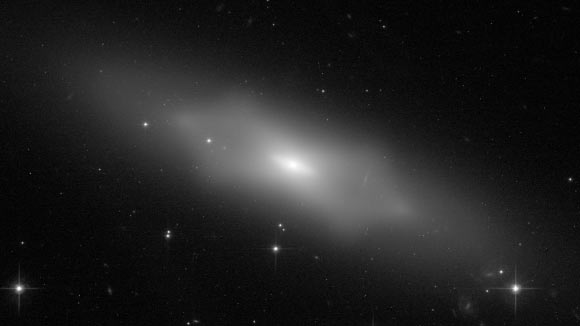Hubble Space Telescope Looks at Stunning Peanut Galaxy | Astronomy – Sci-News.com
Astronomers using the NASA/ESA Hubble Space Telescope have captured an amazing photo of a galaxy called NGC 1175.

This image, taken by Hubble’s Advanced Camera for Surveys (ACS) on July 18, 2019, shows NGC 1175. Image credit: NASA / ESA / Hubble Team.
NGC 1175 is located some 252 million light-years away in the constellation of Perseus.
Also known as LEDA 11578 or UGC 2515, the galaxy was discovered by the German-born British astronomer William Herschel on October 24, 1786.
“Spiral galaxies are characterized by a bright core and vast, pinwheeling arms of gas, dust and stars,” the Hubble astronomers said.
“NGC 1175 is such a galaxy, and also hosts something known as a bar of material that slices through its center.”
“Bars affect how material circulates throughout a galaxy, and look uniquely intriguing from afar.”
“And there’s more: when viewed edge-on, galaxies like this one have an even more peculiar morphology,” they added.
“Their inner regions appear to be thicker in some directions than others, causing them to adopt a shape that is boxy and resembles an unshelled peanut or giant ‘X’.”
In a study published in the Monthly Notices of the Royal Astronomical Society, ESA astronomer Sandor Kruk and colleagues analyzed Hubble data to explore distant galaxies with boxy bulges.
“The team found that these boxy bulges began forming some seven billion years ago, when the Universe was around half its current age,” the researchers said.
“Their formation is related to that of galactic bars, which are thought to have formed about two billion years before the intriguingly shaped bulges began to emerge.”
“The stars within these bars orbit the galactic centre in complex, dynamic ways, with an array of vertical motions that contribute to the galaxies’ observed central boxy morphology.”
NGC 1175 was observed as part of a proposal named ‘Gems of the Galaxy Zoos,’ for which citizen scientists voted on the galaxies they wanted Hubble to observe when the telescope had gaps of time between scheduled projects.
_____
Sandor J. Kruk et al. 2019. Revealing the cosmic evolution of boxy/peanut-shaped bulges from HST COSMOS and SDSS. MNRAS 490 (4): 4721-4739; doi: 10.1093/mnras/stz2877





